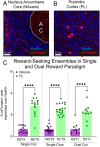This is a preprint.
Characterization of neuronal ensembles in a model of dual reward conditioned place preference
- PMID: 40661519
- PMCID: PMC12259102
- DOI: 10.1101/2025.06.11.659163
Characterization of neuronal ensembles in a model of dual reward conditioned place preference
Abstract
Substance use disorder (SUD) is associated with maladaptive alterations in behavior. Drug-seeking behavior has been associated with neuronal ensembles, defined here as a small group of neurons exhibiting coordinated activity patterns, in the prelimbic prefrontal cortex (PL) and nucleus accumbens core (NAcore). Most SUD preclinical research focuses on the effects of single-reward exposure on the general population of neurons within the reward pathway, rather than on poly-reward exposure. Here, we seek to characterize and compare the ensembles linked to cocaine and chocolate using a within-subject approach. We used Ai14xFos2A-iCreER (c-Fos-TRAP2) transgenic mice to tag neuronal ensembles in a novel dual cocaine and chocolate conditioned place preference (CPP) model, where each chamber was associated with a different reward, either cocaine or chocolate. We found that, after successful dual conditioning and in the absence of the rewards, mice preferred cocaine over chocolate. Additionally, in mice exposed to both cocaine and chocolate, cortical and accumbal ensembles linked to each reward were comparable in size to reward ensembles in mice exposed only to one reward. However, reward-seeking ensembles were larger than ensembles tagged in homecage control mice across groups. We also found that ensemble size does not correlate with the level of reward seeking across single and dual CPP models. These results offer a new paradigm for studying drug-related neuronal ensembles in comparison to natural rewards in non-contingent behavioral models.
Keywords: c-Fos-TRAP2; chocolate; cocaine; dual-reward; neuronal ensembles; nucleus accumbens core; prefrontal cortex.
Conflict of interest statement
Conflict of interest The authors declare that they have no competing financial interests.
Figures





References
Publication types
Grants and funding
LinkOut - more resources
Full Text Sources
Miscellaneous
